Millennial Generation Career Goals
VerifiedAdded on 2020/03/13
|14
|3374
|52
AI Summary
This assignment delves into the career goals of the millennial generation. It examines the influence of cultural values on their aspirations and analyzes how these values shape their educational choices and career trajectories. The assignment encourages a deep understanding of the unique characteristics and motivations driving this influential generation in the modern workforce.
Contribute Materials
Your contribution can guide someone’s learning journey. Share your
documents today.
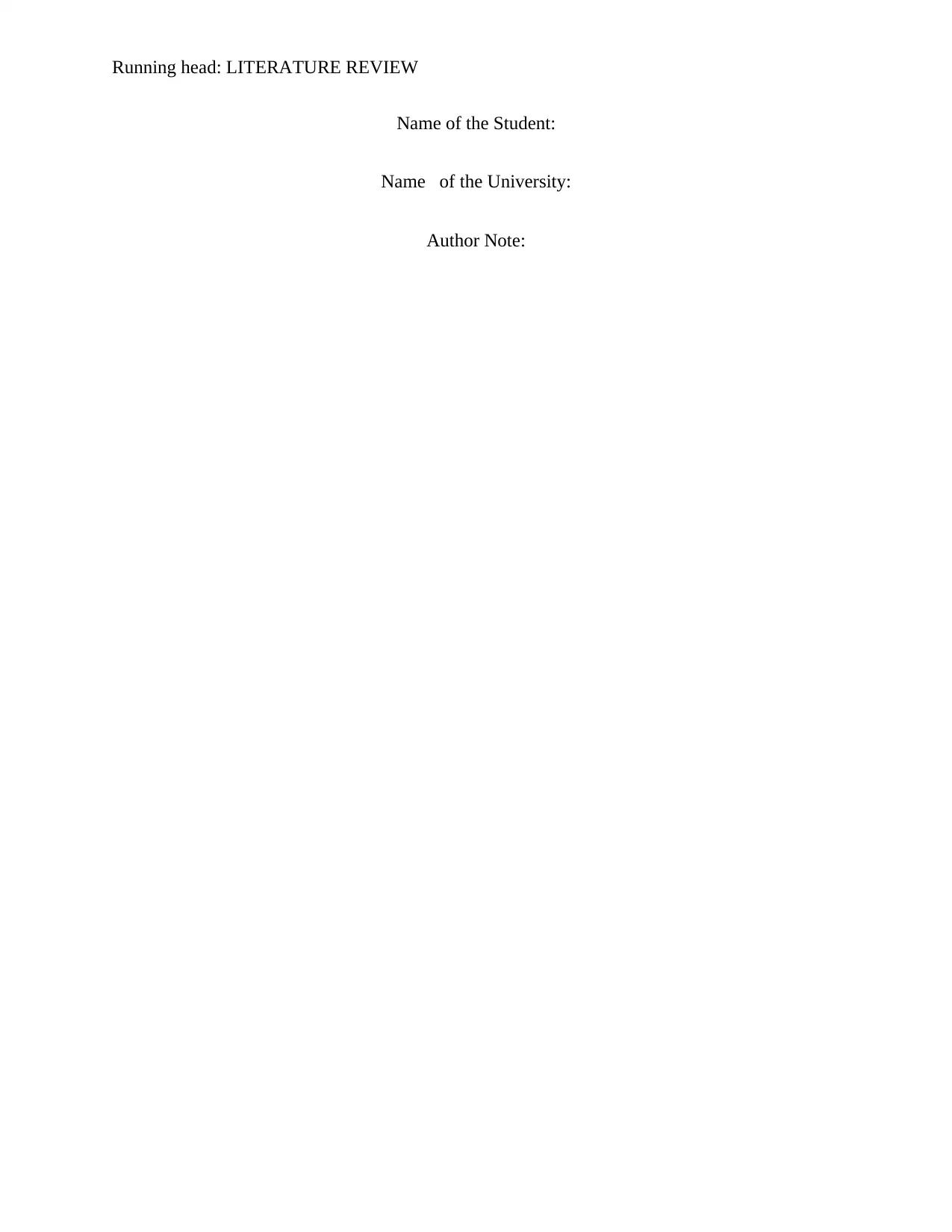
Running head: LITERATURE REVIEW
Name of the Student:
Name of the University:
Author Note:
Name of the Student:
Name of the University:
Author Note:
Secure Best Marks with AI Grader
Need help grading? Try our AI Grader for instant feedback on your assignments.
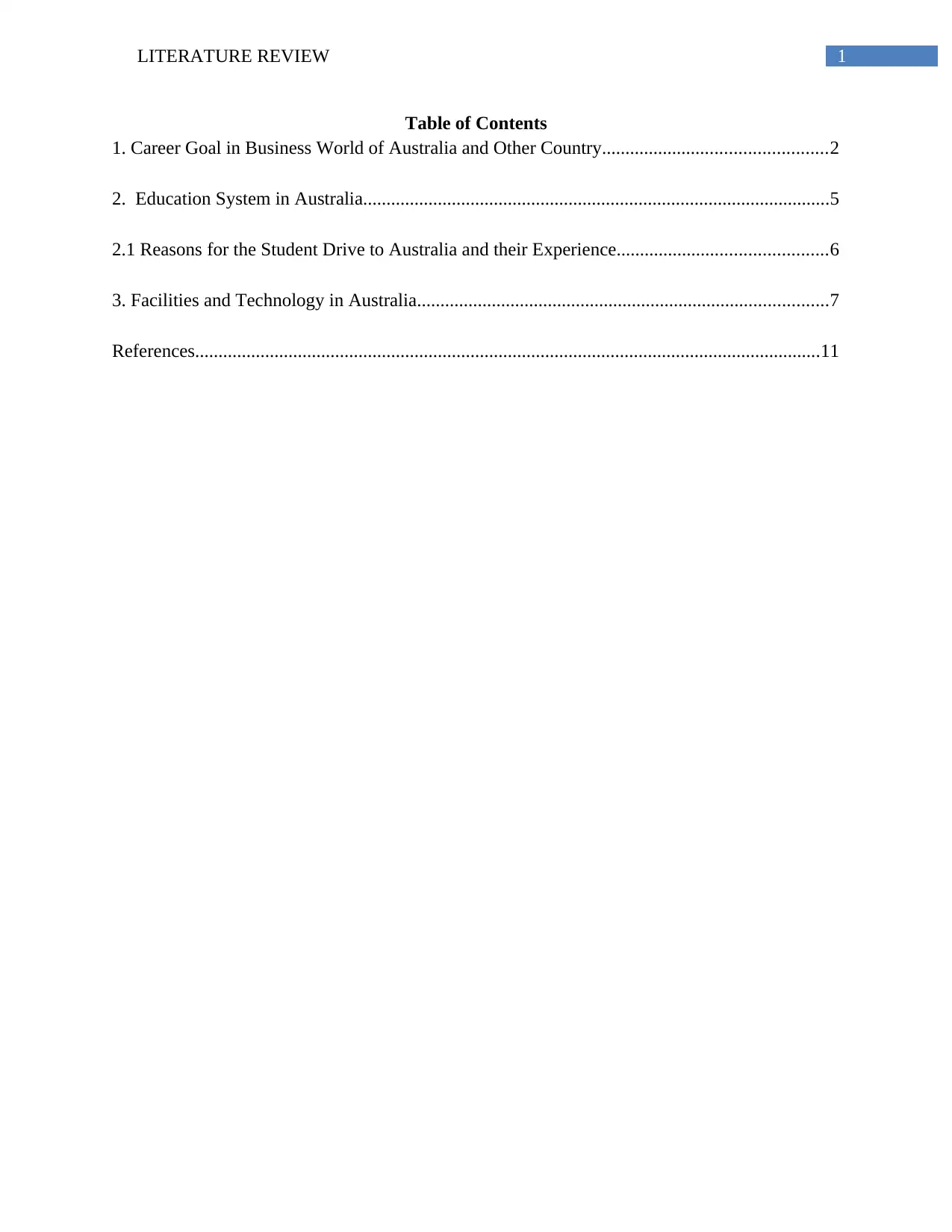
1LITERATURE REVIEW
Table of Contents
1. Career Goal in Business World of Australia and Other Country................................................2
2. Education System in Australia....................................................................................................5
2.1 Reasons for the Student Drive to Australia and their Experience.............................................6
3. Facilities and Technology in Australia........................................................................................7
References......................................................................................................................................11
Table of Contents
1. Career Goal in Business World of Australia and Other Country................................................2
2. Education System in Australia....................................................................................................5
2.1 Reasons for the Student Drive to Australia and their Experience.............................................6
3. Facilities and Technology in Australia........................................................................................7
References......................................................................................................................................11
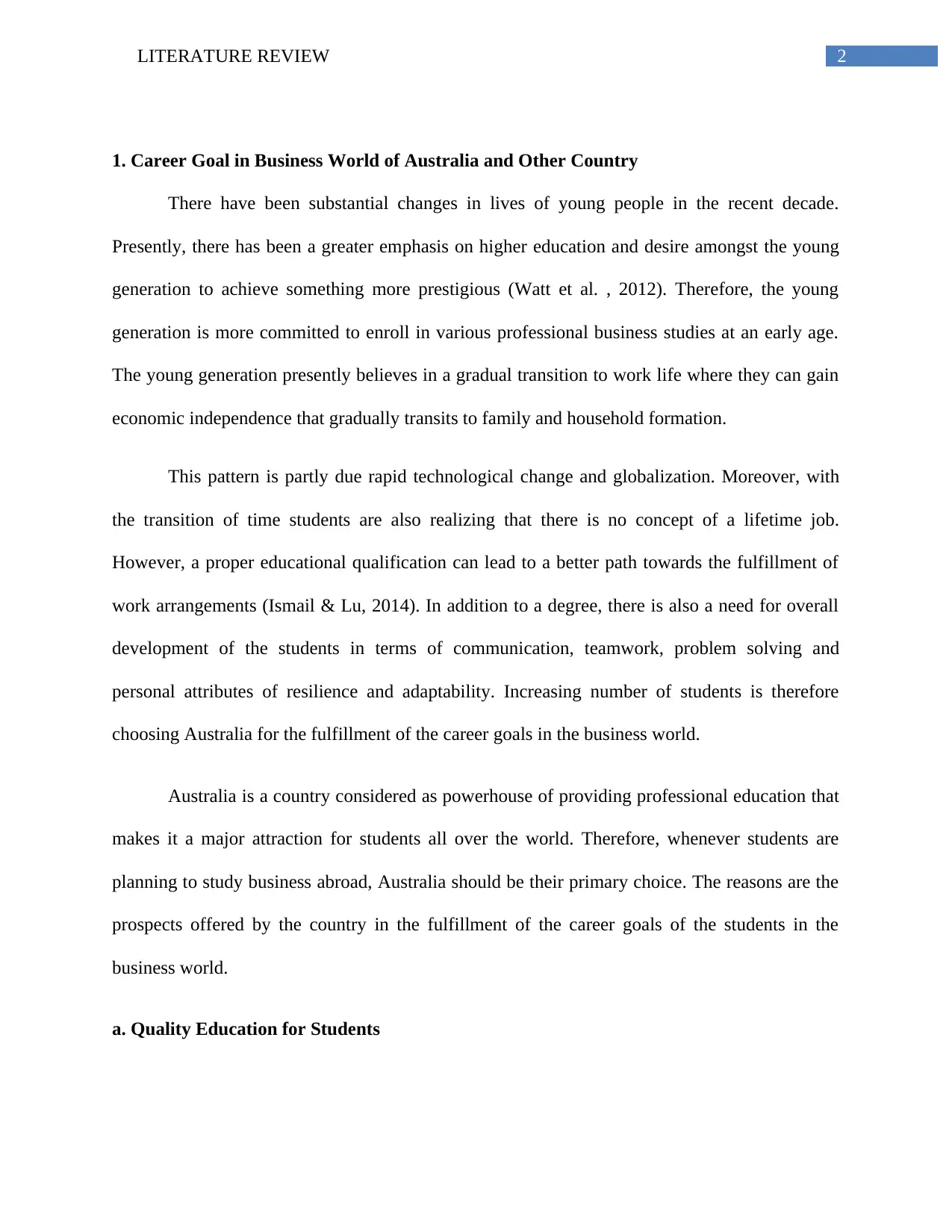
2LITERATURE REVIEW
1. Career Goal in Business World of Australia and Other Country
There have been substantial changes in lives of young people in the recent decade.
Presently, there has been a greater emphasis on higher education and desire amongst the young
generation to achieve something more prestigious (Watt et al. , 2012). Therefore, the young
generation is more committed to enroll in various professional business studies at an early age.
The young generation presently believes in a gradual transition to work life where they can gain
economic independence that gradually transits to family and household formation.
This pattern is partly due rapid technological change and globalization. Moreover, with
the transition of time students are also realizing that there is no concept of a lifetime job.
However, a proper educational qualification can lead to a better path towards the fulfillment of
work arrangements (Ismail & Lu, 2014). In addition to a degree, there is also a need for overall
development of the students in terms of communication, teamwork, problem solving and
personal attributes of resilience and adaptability. Increasing number of students is therefore
choosing Australia for the fulfillment of the career goals in the business world.
Australia is a country considered as powerhouse of providing professional education that
makes it a major attraction for students all over the world. Therefore, whenever students are
planning to study business abroad, Australia should be their primary choice. The reasons are the
prospects offered by the country in the fulfillment of the career goals of the students in the
business world.
a. Quality Education for Students
1. Career Goal in Business World of Australia and Other Country
There have been substantial changes in lives of young people in the recent decade.
Presently, there has been a greater emphasis on higher education and desire amongst the young
generation to achieve something more prestigious (Watt et al. , 2012). Therefore, the young
generation is more committed to enroll in various professional business studies at an early age.
The young generation presently believes in a gradual transition to work life where they can gain
economic independence that gradually transits to family and household formation.
This pattern is partly due rapid technological change and globalization. Moreover, with
the transition of time students are also realizing that there is no concept of a lifetime job.
However, a proper educational qualification can lead to a better path towards the fulfillment of
work arrangements (Ismail & Lu, 2014). In addition to a degree, there is also a need for overall
development of the students in terms of communication, teamwork, problem solving and
personal attributes of resilience and adaptability. Increasing number of students is therefore
choosing Australia for the fulfillment of the career goals in the business world.
Australia is a country considered as powerhouse of providing professional education that
makes it a major attraction for students all over the world. Therefore, whenever students are
planning to study business abroad, Australia should be their primary choice. The reasons are the
prospects offered by the country in the fulfillment of the career goals of the students in the
business world.
a. Quality Education for Students
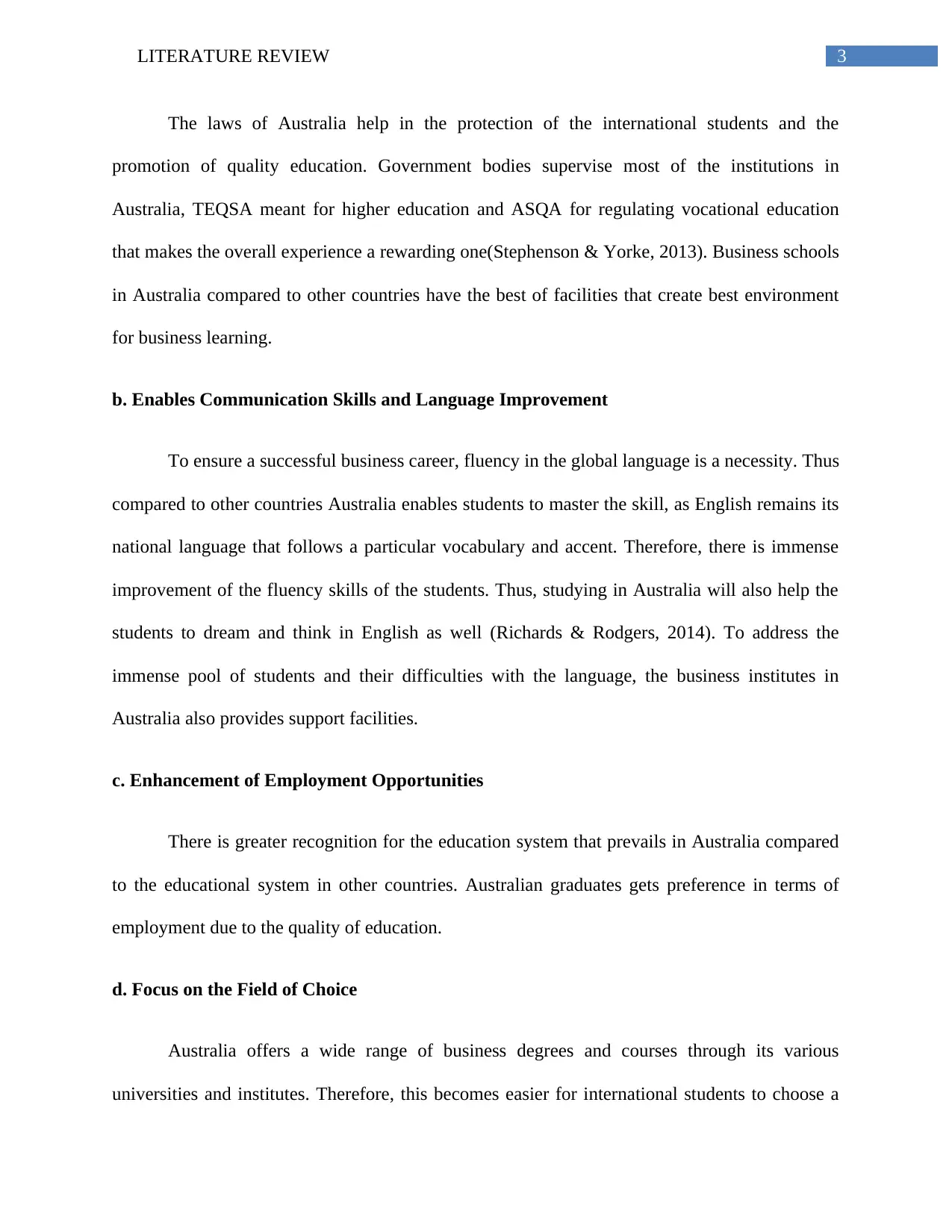
3LITERATURE REVIEW
The laws of Australia help in the protection of the international students and the
promotion of quality education. Government bodies supervise most of the institutions in
Australia, TEQSA meant for higher education and ASQA for regulating vocational education
that makes the overall experience a rewarding one(Stephenson & Yorke, 2013). Business schools
in Australia compared to other countries have the best of facilities that create best environment
for business learning.
b. Enables Communication Skills and Language Improvement
To ensure a successful business career, fluency in the global language is a necessity. Thus
compared to other countries Australia enables students to master the skill, as English remains its
national language that follows a particular vocabulary and accent. Therefore, there is immense
improvement of the fluency skills of the students. Thus, studying in Australia will also help the
students to dream and think in English as well (Richards & Rodgers, 2014). To address the
immense pool of students and their difficulties with the language, the business institutes in
Australia also provides support facilities.
c. Enhancement of Employment Opportunities
There is greater recognition for the education system that prevails in Australia compared
to the educational system in other countries. Australian graduates gets preference in terms of
employment due to the quality of education.
d. Focus on the Field of Choice
Australia offers a wide range of business degrees and courses through its various
universities and institutes. Therefore, this becomes easier for international students to choose a
The laws of Australia help in the protection of the international students and the
promotion of quality education. Government bodies supervise most of the institutions in
Australia, TEQSA meant for higher education and ASQA for regulating vocational education
that makes the overall experience a rewarding one(Stephenson & Yorke, 2013). Business schools
in Australia compared to other countries have the best of facilities that create best environment
for business learning.
b. Enables Communication Skills and Language Improvement
To ensure a successful business career, fluency in the global language is a necessity. Thus
compared to other countries Australia enables students to master the skill, as English remains its
national language that follows a particular vocabulary and accent. Therefore, there is immense
improvement of the fluency skills of the students. Thus, studying in Australia will also help the
students to dream and think in English as well (Richards & Rodgers, 2014). To address the
immense pool of students and their difficulties with the language, the business institutes in
Australia also provides support facilities.
c. Enhancement of Employment Opportunities
There is greater recognition for the education system that prevails in Australia compared
to the educational system in other countries. Australian graduates gets preference in terms of
employment due to the quality of education.
d. Focus on the Field of Choice
Australia offers a wide range of business degrees and courses through its various
universities and institutes. Therefore, this becomes easier for international students to choose a
Secure Best Marks with AI Grader
Need help grading? Try our AI Grader for instant feedback on your assignments.
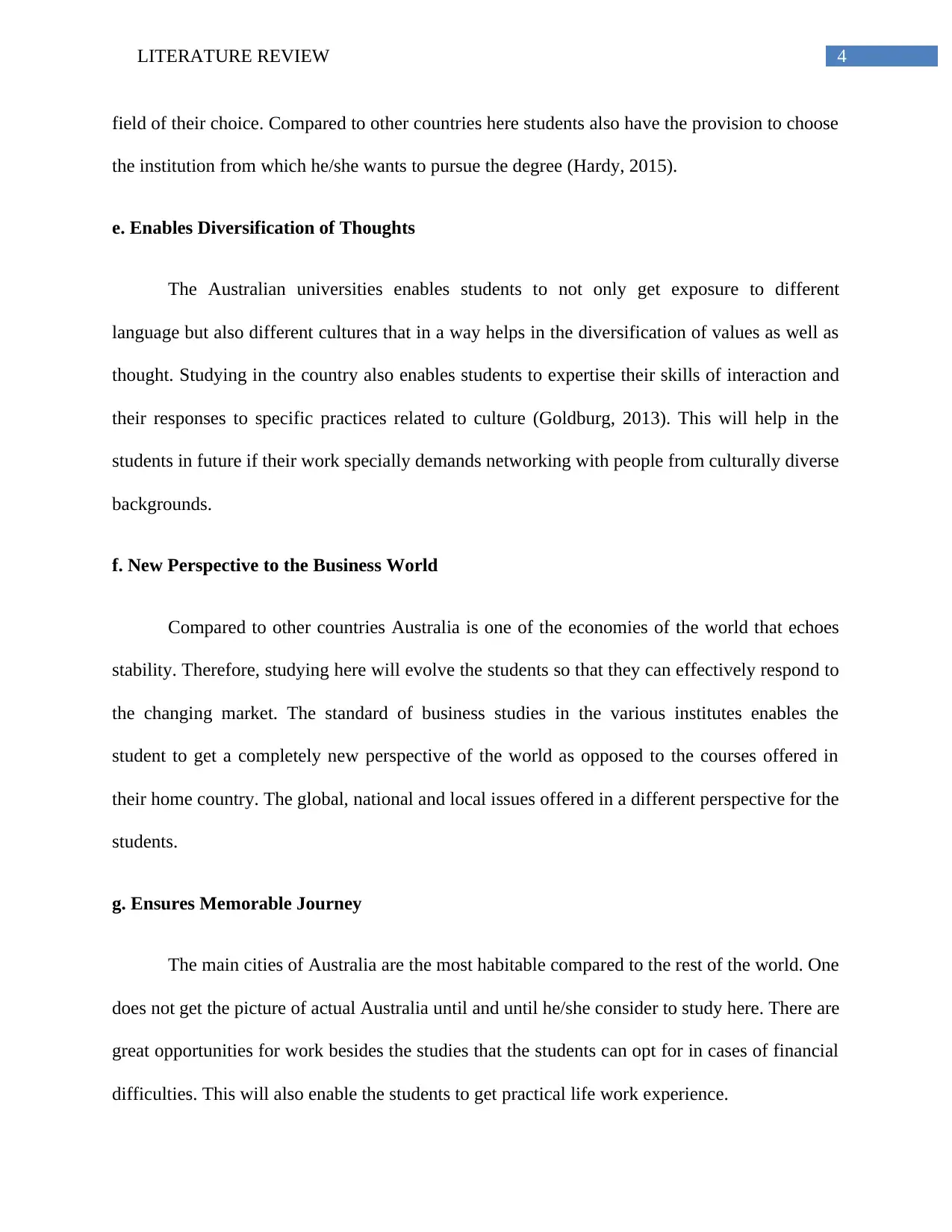
4LITERATURE REVIEW
field of their choice. Compared to other countries here students also have the provision to choose
the institution from which he/she wants to pursue the degree (Hardy, 2015).
e. Enables Diversification of Thoughts
The Australian universities enables students to not only get exposure to different
language but also different cultures that in a way helps in the diversification of values as well as
thought. Studying in the country also enables students to expertise their skills of interaction and
their responses to specific practices related to culture (Goldburg, 2013). This will help in the
students in future if their work specially demands networking with people from culturally diverse
backgrounds.
f. New Perspective to the Business World
Compared to other countries Australia is one of the economies of the world that echoes
stability. Therefore, studying here will evolve the students so that they can effectively respond to
the changing market. The standard of business studies in the various institutes enables the
student to get a completely new perspective of the world as opposed to the courses offered in
their home country. The global, national and local issues offered in a different perspective for the
students.
g. Ensures Memorable Journey
The main cities of Australia are the most habitable compared to the rest of the world. One
does not get the picture of actual Australia until and until he/she consider to study here. There are
great opportunities for work besides the studies that the students can opt for in cases of financial
difficulties. This will also enable the students to get practical life work experience.
field of their choice. Compared to other countries here students also have the provision to choose
the institution from which he/she wants to pursue the degree (Hardy, 2015).
e. Enables Diversification of Thoughts
The Australian universities enables students to not only get exposure to different
language but also different cultures that in a way helps in the diversification of values as well as
thought. Studying in the country also enables students to expertise their skills of interaction and
their responses to specific practices related to culture (Goldburg, 2013). This will help in the
students in future if their work specially demands networking with people from culturally diverse
backgrounds.
f. New Perspective to the Business World
Compared to other countries Australia is one of the economies of the world that echoes
stability. Therefore, studying here will evolve the students so that they can effectively respond to
the changing market. The standard of business studies in the various institutes enables the
student to get a completely new perspective of the world as opposed to the courses offered in
their home country. The global, national and local issues offered in a different perspective for the
students.
g. Ensures Memorable Journey
The main cities of Australia are the most habitable compared to the rest of the world. One
does not get the picture of actual Australia until and until he/she consider to study here. There are
great opportunities for work besides the studies that the students can opt for in cases of financial
difficulties. This will also enable the students to get practical life work experience.
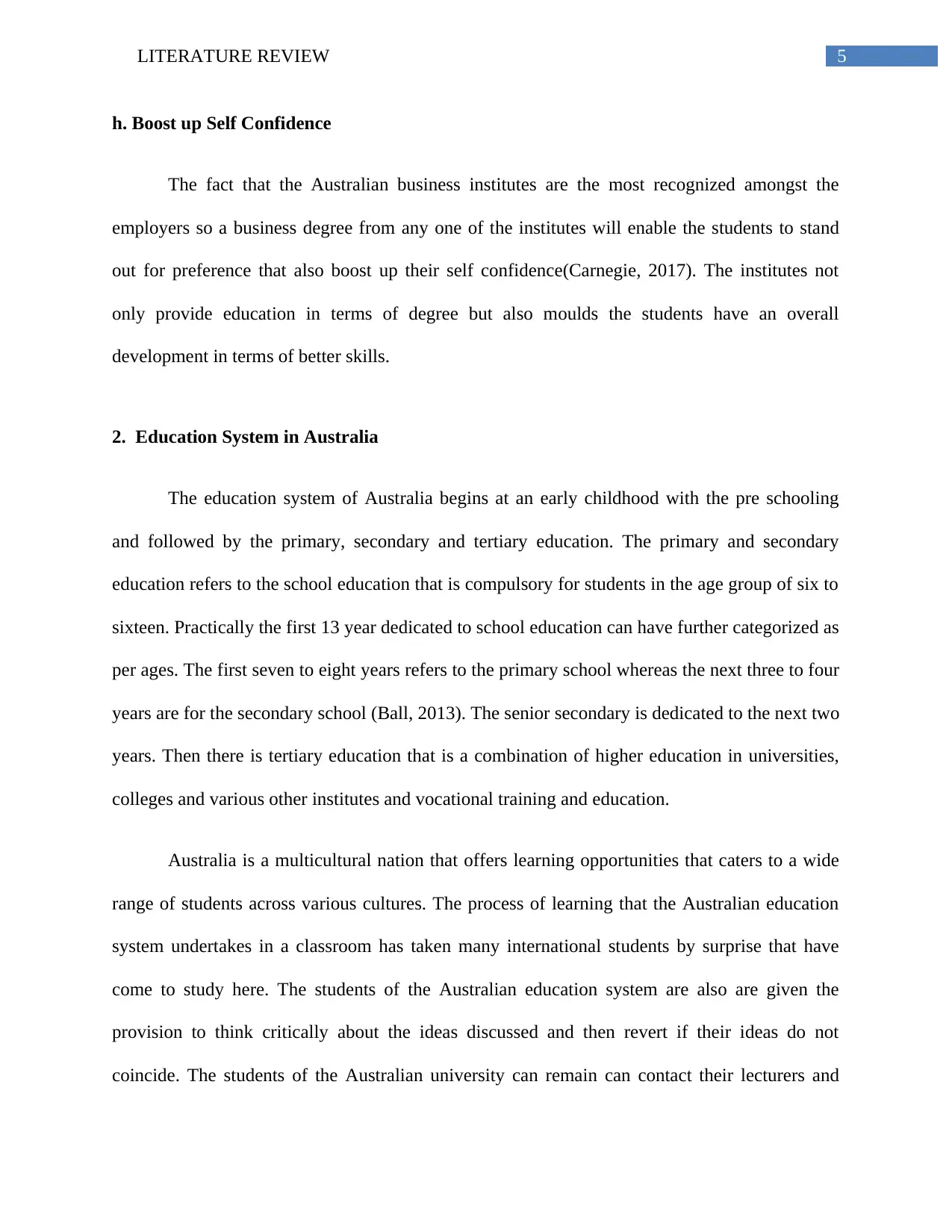
5LITERATURE REVIEW
h. Boost up Self Confidence
The fact that the Australian business institutes are the most recognized amongst the
employers so a business degree from any one of the institutes will enable the students to stand
out for preference that also boost up their self confidence(Carnegie, 2017). The institutes not
only provide education in terms of degree but also moulds the students have an overall
development in terms of better skills.
2. Education System in Australia
The education system of Australia begins at an early childhood with the pre schooling
and followed by the primary, secondary and tertiary education. The primary and secondary
education refers to the school education that is compulsory for students in the age group of six to
sixteen. Practically the first 13 year dedicated to school education can have further categorized as
per ages. The first seven to eight years refers to the primary school whereas the next three to four
years are for the secondary school (Ball, 2013). The senior secondary is dedicated to the next two
years. Then there is tertiary education that is a combination of higher education in universities,
colleges and various other institutes and vocational training and education.
Australia is a multicultural nation that offers learning opportunities that caters to a wide
range of students across various cultures. The process of learning that the Australian education
system undertakes in a classroom has taken many international students by surprise that have
come to study here. The students of the Australian education system are also are given the
provision to think critically about the ideas discussed and then revert if their ideas do not
coincide. The students of the Australian university can remain can contact their lecturers and
h. Boost up Self Confidence
The fact that the Australian business institutes are the most recognized amongst the
employers so a business degree from any one of the institutes will enable the students to stand
out for preference that also boost up their self confidence(Carnegie, 2017). The institutes not
only provide education in terms of degree but also moulds the students have an overall
development in terms of better skills.
2. Education System in Australia
The education system of Australia begins at an early childhood with the pre schooling
and followed by the primary, secondary and tertiary education. The primary and secondary
education refers to the school education that is compulsory for students in the age group of six to
sixteen. Practically the first 13 year dedicated to school education can have further categorized as
per ages. The first seven to eight years refers to the primary school whereas the next three to four
years are for the secondary school (Ball, 2013). The senior secondary is dedicated to the next two
years. Then there is tertiary education that is a combination of higher education in universities,
colleges and various other institutes and vocational training and education.
Australia is a multicultural nation that offers learning opportunities that caters to a wide
range of students across various cultures. The process of learning that the Australian education
system undertakes in a classroom has taken many international students by surprise that have
come to study here. The students of the Australian education system are also are given the
provision to think critically about the ideas discussed and then revert if their ideas do not
coincide. The students of the Australian university can remain can contact their lecturers and
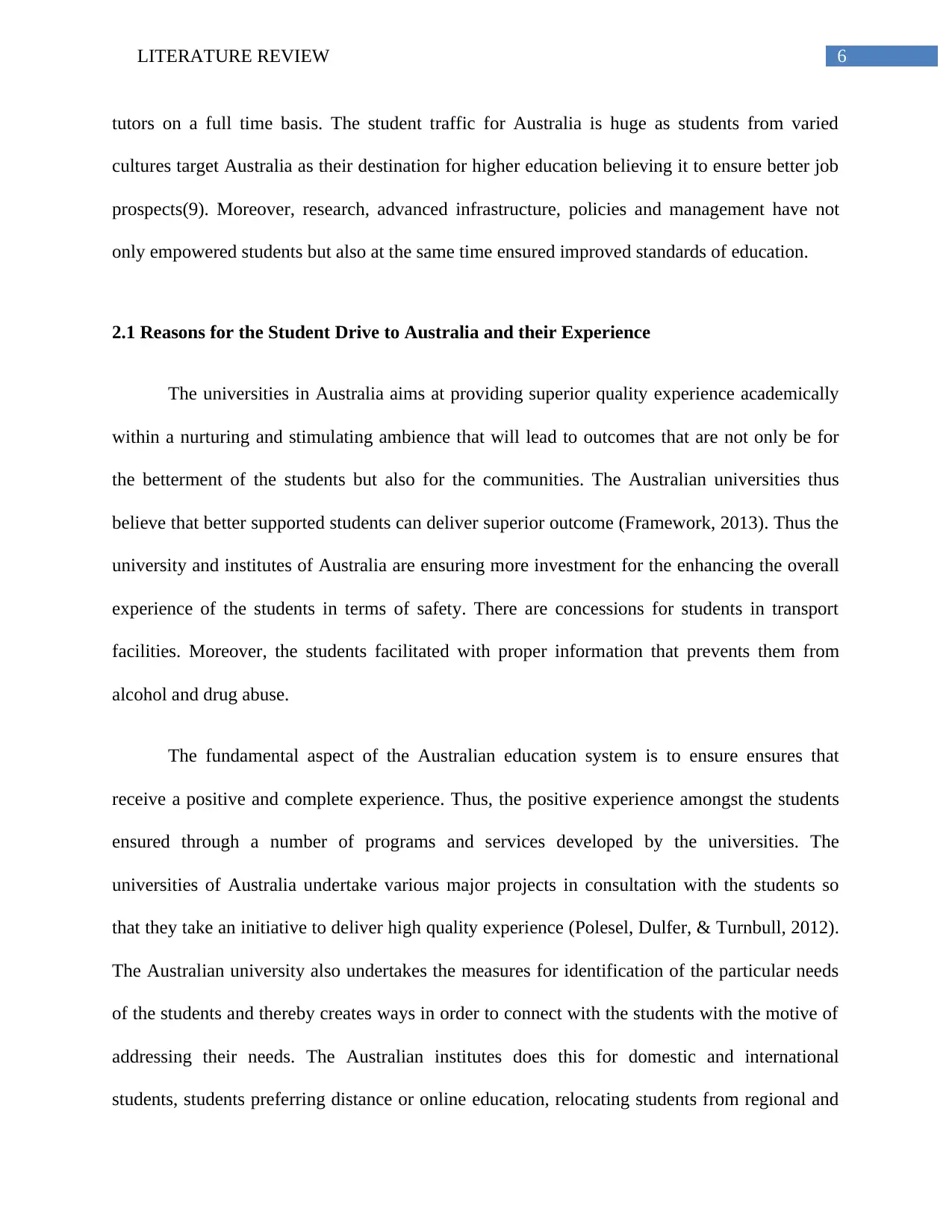
6LITERATURE REVIEW
tutors on a full time basis. The student traffic for Australia is huge as students from varied
cultures target Australia as their destination for higher education believing it to ensure better job
prospects(9). Moreover, research, advanced infrastructure, policies and management have not
only empowered students but also at the same time ensured improved standards of education.
2.1 Reasons for the Student Drive to Australia and their Experience
The universities in Australia aims at providing superior quality experience academically
within a nurturing and stimulating ambience that will lead to outcomes that are not only be for
the betterment of the students but also for the communities. The Australian universities thus
believe that better supported students can deliver superior outcome (Framework, 2013). Thus the
university and institutes of Australia are ensuring more investment for the enhancing the overall
experience of the students in terms of safety. There are concessions for students in transport
facilities. Moreover, the students facilitated with proper information that prevents them from
alcohol and drug abuse.
The fundamental aspect of the Australian education system is to ensure ensures that
receive a positive and complete experience. Thus, the positive experience amongst the students
ensured through a number of programs and services developed by the universities. The
universities of Australia undertake various major projects in consultation with the students so
that they take an initiative to deliver high quality experience (Polesel, Dulfer, & Turnbull, 2012).
The Australian university also undertakes the measures for identification of the particular needs
of the students and thereby creates ways in order to connect with the students with the motive of
addressing their needs. The Australian institutes does this for domestic and international
students, students preferring distance or online education, relocating students from regional and
tutors on a full time basis. The student traffic for Australia is huge as students from varied
cultures target Australia as their destination for higher education believing it to ensure better job
prospects(9). Moreover, research, advanced infrastructure, policies and management have not
only empowered students but also at the same time ensured improved standards of education.
2.1 Reasons for the Student Drive to Australia and their Experience
The universities in Australia aims at providing superior quality experience academically
within a nurturing and stimulating ambience that will lead to outcomes that are not only be for
the betterment of the students but also for the communities. The Australian universities thus
believe that better supported students can deliver superior outcome (Framework, 2013). Thus the
university and institutes of Australia are ensuring more investment for the enhancing the overall
experience of the students in terms of safety. There are concessions for students in transport
facilities. Moreover, the students facilitated with proper information that prevents them from
alcohol and drug abuse.
The fundamental aspect of the Australian education system is to ensure ensures that
receive a positive and complete experience. Thus, the positive experience amongst the students
ensured through a number of programs and services developed by the universities. The
universities of Australia undertake various major projects in consultation with the students so
that they take an initiative to deliver high quality experience (Polesel, Dulfer, & Turnbull, 2012).
The Australian university also undertakes the measures for identification of the particular needs
of the students and thereby creates ways in order to connect with the students with the motive of
addressing their needs. The Australian institutes does this for domestic and international
students, students preferring distance or online education, relocating students from regional and
Paraphrase This Document
Need a fresh take? Get an instant paraphrase of this document with our AI Paraphraser
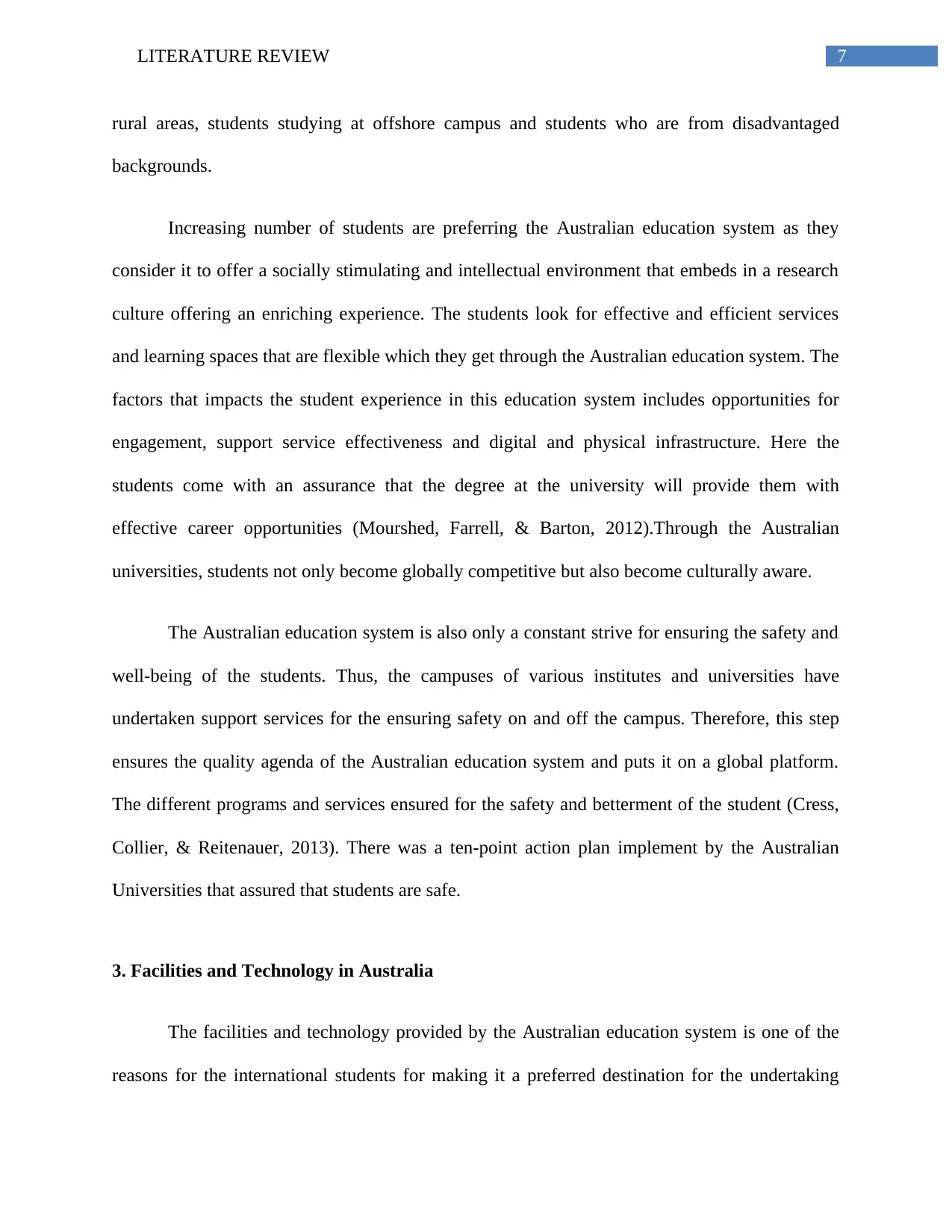
7LITERATURE REVIEW
rural areas, students studying at offshore campus and students who are from disadvantaged
backgrounds.
Increasing number of students are preferring the Australian education system as they
consider it to offer a socially stimulating and intellectual environment that embeds in a research
culture offering an enriching experience. The students look for effective and efficient services
and learning spaces that are flexible which they get through the Australian education system. The
factors that impacts the student experience in this education system includes opportunities for
engagement, support service effectiveness and digital and physical infrastructure. Here the
students come with an assurance that the degree at the university will provide them with
effective career opportunities (Mourshed, Farrell, & Barton, 2012).Through the Australian
universities, students not only become globally competitive but also become culturally aware.
The Australian education system is also only a constant strive for ensuring the safety and
well-being of the students. Thus, the campuses of various institutes and universities have
undertaken support services for the ensuring safety on and off the campus. Therefore, this step
ensures the quality agenda of the Australian education system and puts it on a global platform.
The different programs and services ensured for the safety and betterment of the student (Cress,
Collier, & Reitenauer, 2013). There was a ten-point action plan implement by the Australian
Universities that assured that students are safe.
3. Facilities and Technology in Australia
The facilities and technology provided by the Australian education system is one of the
reasons for the international students for making it a preferred destination for the undertaking
rural areas, students studying at offshore campus and students who are from disadvantaged
backgrounds.
Increasing number of students are preferring the Australian education system as they
consider it to offer a socially stimulating and intellectual environment that embeds in a research
culture offering an enriching experience. The students look for effective and efficient services
and learning spaces that are flexible which they get through the Australian education system. The
factors that impacts the student experience in this education system includes opportunities for
engagement, support service effectiveness and digital and physical infrastructure. Here the
students come with an assurance that the degree at the university will provide them with
effective career opportunities (Mourshed, Farrell, & Barton, 2012).Through the Australian
universities, students not only become globally competitive but also become culturally aware.
The Australian education system is also only a constant strive for ensuring the safety and
well-being of the students. Thus, the campuses of various institutes and universities have
undertaken support services for the ensuring safety on and off the campus. Therefore, this step
ensures the quality agenda of the Australian education system and puts it on a global platform.
The different programs and services ensured for the safety and betterment of the student (Cress,
Collier, & Reitenauer, 2013). There was a ten-point action plan implement by the Australian
Universities that assured that students are safe.
3. Facilities and Technology in Australia
The facilities and technology provided by the Australian education system is one of the
reasons for the international students for making it a preferred destination for the undertaking
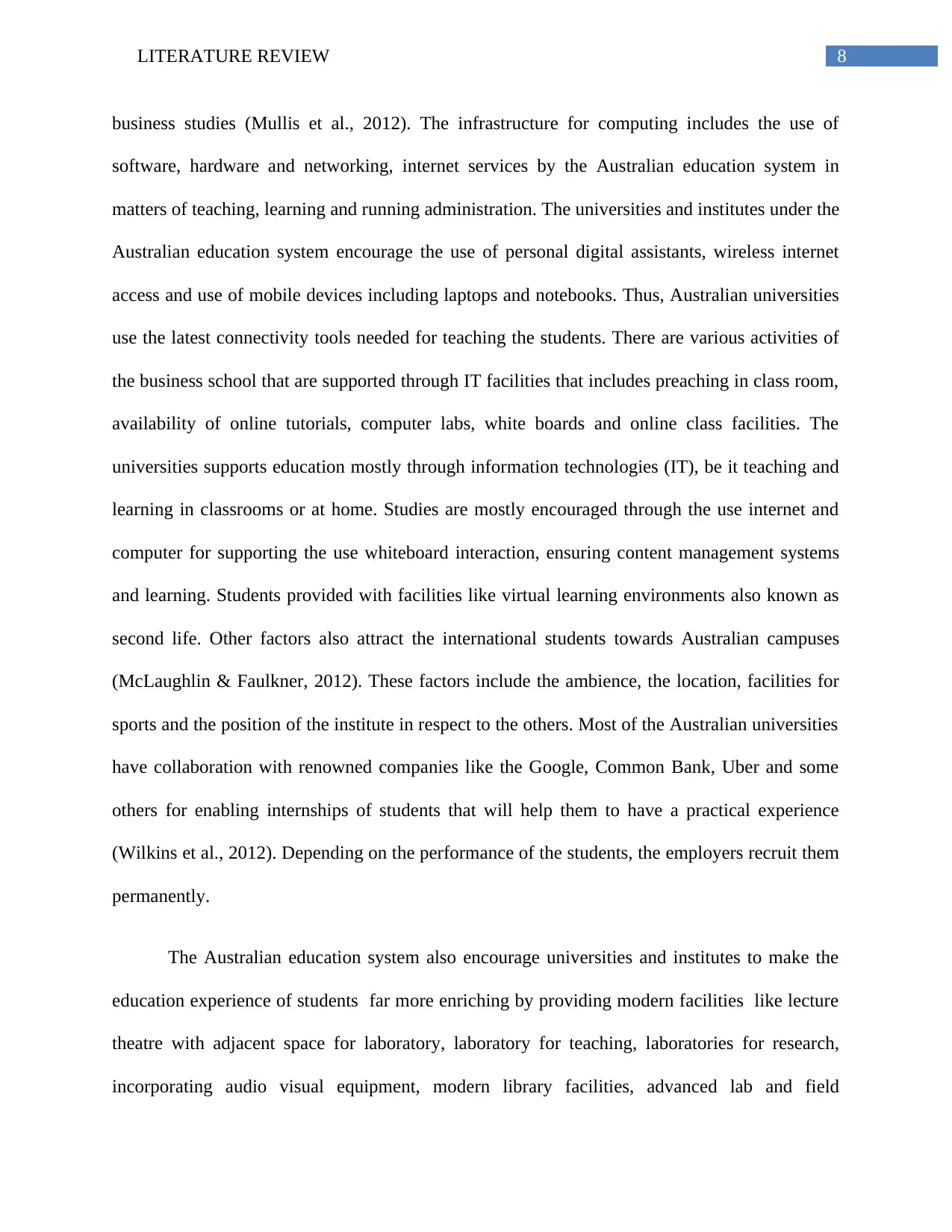
8LITERATURE REVIEW
business studies (Mullis et al., 2012). The infrastructure for computing includes the use of
software, hardware and networking, internet services by the Australian education system in
matters of teaching, learning and running administration. The universities and institutes under the
Australian education system encourage the use of personal digital assistants, wireless internet
access and use of mobile devices including laptops and notebooks. Thus, Australian universities
use the latest connectivity tools needed for teaching the students. There are various activities of
the business school that are supported through IT facilities that includes preaching in class room,
availability of online tutorials, computer labs, white boards and online class facilities. The
universities supports education mostly through information technologies (IT), be it teaching and
learning in classrooms or at home. Studies are mostly encouraged through the use internet and
computer for supporting the use whiteboard interaction, ensuring content management systems
and learning. Students provided with facilities like virtual learning environments also known as
second life. Other factors also attract the international students towards Australian campuses
(McLaughlin & Faulkner, 2012). These factors include the ambience, the location, facilities for
sports and the position of the institute in respect to the others. Most of the Australian universities
have collaboration with renowned companies like the Google, Common Bank, Uber and some
others for enabling internships of students that will help them to have a practical experience
(Wilkins et al., 2012). Depending on the performance of the students, the employers recruit them
permanently.
The Australian education system also encourage universities and institutes to make the
education experience of students far more enriching by providing modern facilities like lecture
theatre with adjacent space for laboratory, laboratory for teaching, laboratories for research,
incorporating audio visual equipment, modern library facilities, advanced lab and field
business studies (Mullis et al., 2012). The infrastructure for computing includes the use of
software, hardware and networking, internet services by the Australian education system in
matters of teaching, learning and running administration. The universities and institutes under the
Australian education system encourage the use of personal digital assistants, wireless internet
access and use of mobile devices including laptops and notebooks. Thus, Australian universities
use the latest connectivity tools needed for teaching the students. There are various activities of
the business school that are supported through IT facilities that includes preaching in class room,
availability of online tutorials, computer labs, white boards and online class facilities. The
universities supports education mostly through information technologies (IT), be it teaching and
learning in classrooms or at home. Studies are mostly encouraged through the use internet and
computer for supporting the use whiteboard interaction, ensuring content management systems
and learning. Students provided with facilities like virtual learning environments also known as
second life. Other factors also attract the international students towards Australian campuses
(McLaughlin & Faulkner, 2012). These factors include the ambience, the location, facilities for
sports and the position of the institute in respect to the others. Most of the Australian universities
have collaboration with renowned companies like the Google, Common Bank, Uber and some
others for enabling internships of students that will help them to have a practical experience
(Wilkins et al., 2012). Depending on the performance of the students, the employers recruit them
permanently.
The Australian education system also encourage universities and institutes to make the
education experience of students far more enriching by providing modern facilities like lecture
theatre with adjacent space for laboratory, laboratory for teaching, laboratories for research,
incorporating audio visual equipment, modern library facilities, advanced lab and field
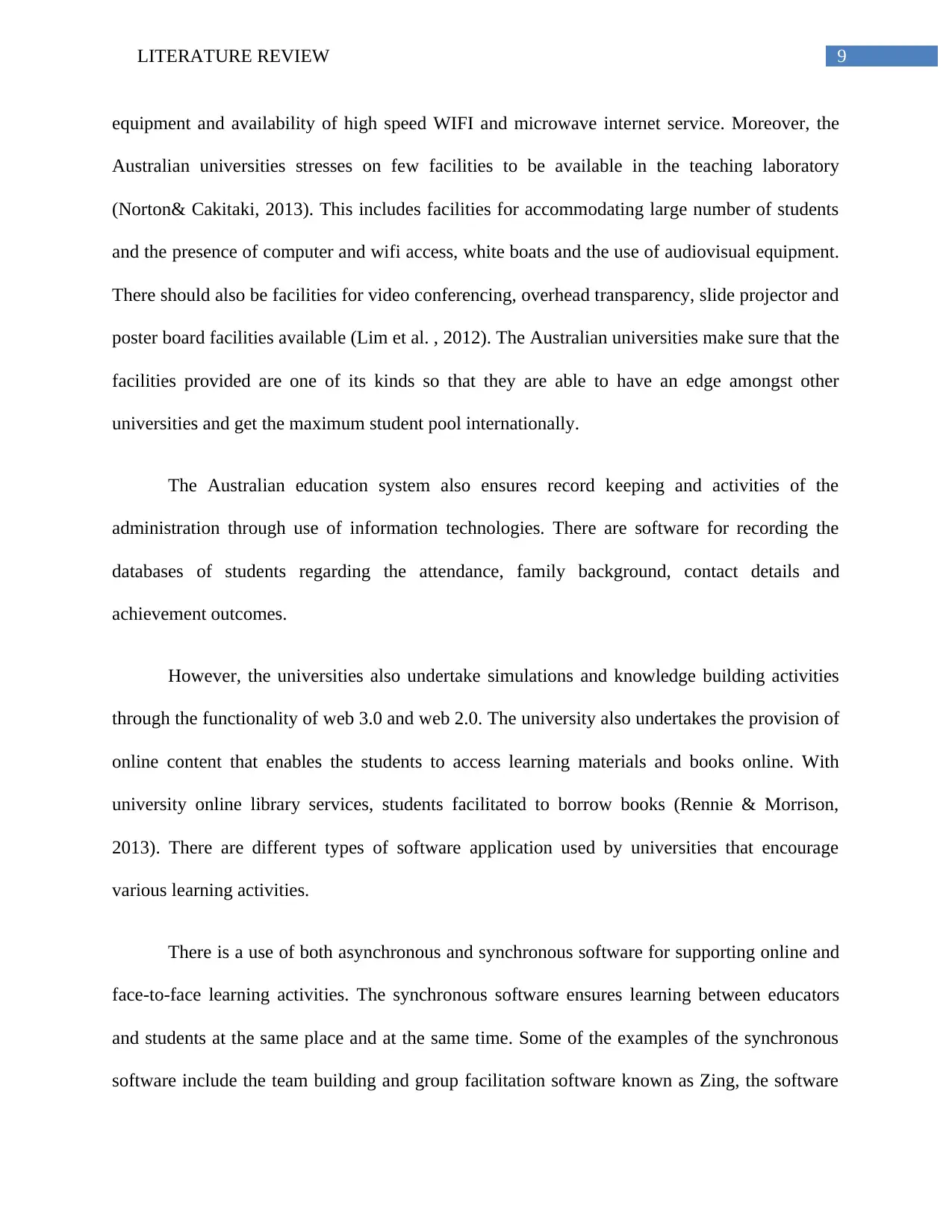
9LITERATURE REVIEW
equipment and availability of high speed WIFI and microwave internet service. Moreover, the
Australian universities stresses on few facilities to be available in the teaching laboratory
(Norton& Cakitaki, 2013). This includes facilities for accommodating large number of students
and the presence of computer and wifi access, white boats and the use of audiovisual equipment.
There should also be facilities for video conferencing, overhead transparency, slide projector and
poster board facilities available (Lim et al. , 2012). The Australian universities make sure that the
facilities provided are one of its kinds so that they are able to have an edge amongst other
universities and get the maximum student pool internationally.
The Australian education system also ensures record keeping and activities of the
administration through use of information technologies. There are software for recording the
databases of students regarding the attendance, family background, contact details and
achievement outcomes.
However, the universities also undertake simulations and knowledge building activities
through the functionality of web 3.0 and web 2.0. The university also undertakes the provision of
online content that enables the students to access learning materials and books online. With
university online library services, students facilitated to borrow books (Rennie & Morrison,
2013). There are different types of software application used by universities that encourage
various learning activities.
There is a use of both asynchronous and synchronous software for supporting online and
face-to-face learning activities. The synchronous software ensures learning between educators
and students at the same place and at the same time. Some of the examples of the synchronous
software include the team building and group facilitation software known as Zing, the software
equipment and availability of high speed WIFI and microwave internet service. Moreover, the
Australian universities stresses on few facilities to be available in the teaching laboratory
(Norton& Cakitaki, 2013). This includes facilities for accommodating large number of students
and the presence of computer and wifi access, white boats and the use of audiovisual equipment.
There should also be facilities for video conferencing, overhead transparency, slide projector and
poster board facilities available (Lim et al. , 2012). The Australian universities make sure that the
facilities provided are one of its kinds so that they are able to have an edge amongst other
universities and get the maximum student pool internationally.
The Australian education system also ensures record keeping and activities of the
administration through use of information technologies. There are software for recording the
databases of students regarding the attendance, family background, contact details and
achievement outcomes.
However, the universities also undertake simulations and knowledge building activities
through the functionality of web 3.0 and web 2.0. The university also undertakes the provision of
online content that enables the students to access learning materials and books online. With
university online library services, students facilitated to borrow books (Rennie & Morrison,
2013). There are different types of software application used by universities that encourage
various learning activities.
There is a use of both asynchronous and synchronous software for supporting online and
face-to-face learning activities. The synchronous software ensures learning between educators
and students at the same place and at the same time. Some of the examples of the synchronous
software include the team building and group facilitation software known as Zing, the software
Secure Best Marks with AI Grader
Need help grading? Try our AI Grader for instant feedback on your assignments.
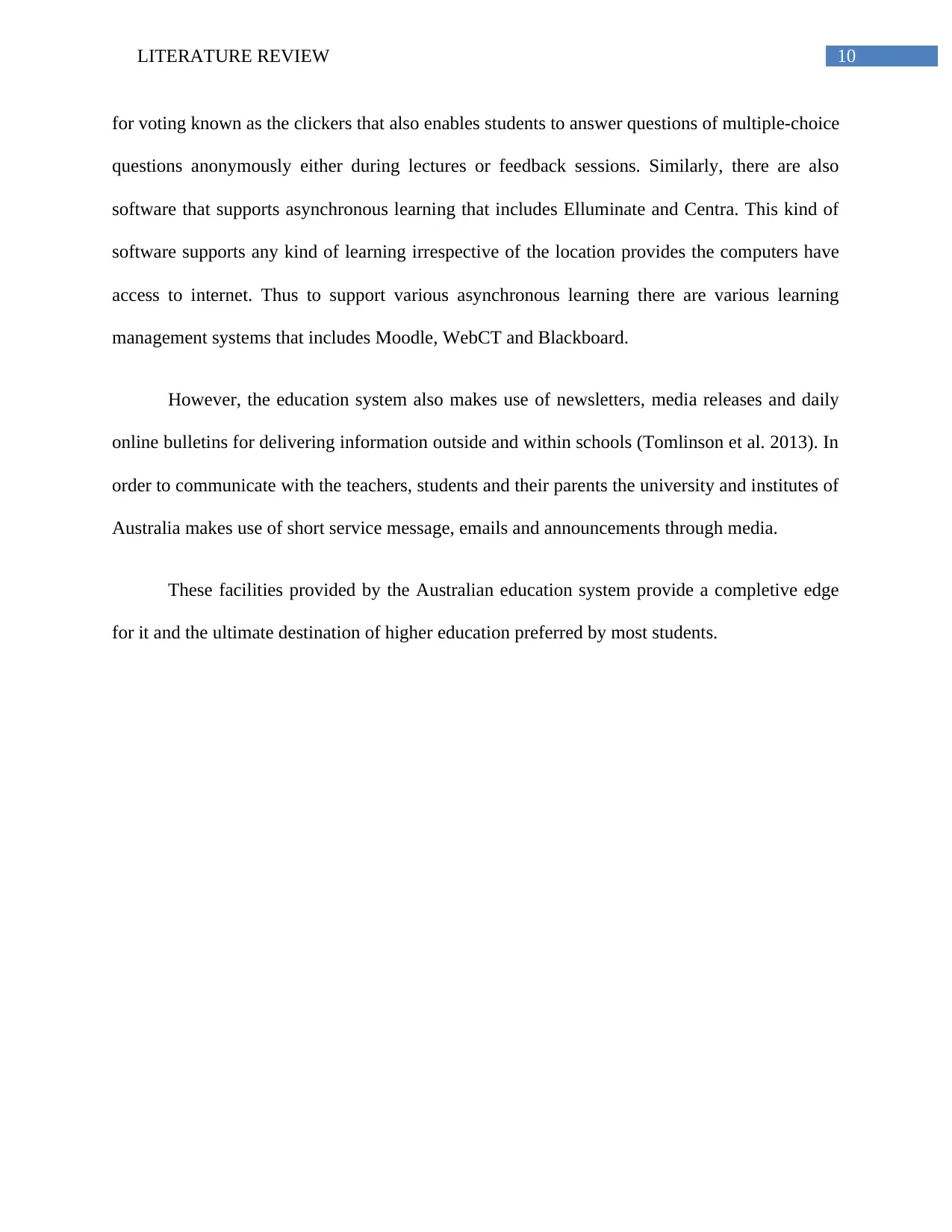
10LITERATURE REVIEW
for voting known as the clickers that also enables students to answer questions of multiple-choice
questions anonymously either during lectures or feedback sessions. Similarly, there are also
software that supports asynchronous learning that includes Elluminate and Centra. This kind of
software supports any kind of learning irrespective of the location provides the computers have
access to internet. Thus to support various asynchronous learning there are various learning
management systems that includes Moodle, WebCT and Blackboard.
However, the education system also makes use of newsletters, media releases and daily
online bulletins for delivering information outside and within schools (Tomlinson et al. 2013). In
order to communicate with the teachers, students and their parents the university and institutes of
Australia makes use of short service message, emails and announcements through media.
These facilities provided by the Australian education system provide a completive edge
for it and the ultimate destination of higher education preferred by most students.
for voting known as the clickers that also enables students to answer questions of multiple-choice
questions anonymously either during lectures or feedback sessions. Similarly, there are also
software that supports asynchronous learning that includes Elluminate and Centra. This kind of
software supports any kind of learning irrespective of the location provides the computers have
access to internet. Thus to support various asynchronous learning there are various learning
management systems that includes Moodle, WebCT and Blackboard.
However, the education system also makes use of newsletters, media releases and daily
online bulletins for delivering information outside and within schools (Tomlinson et al. 2013). In
order to communicate with the teachers, students and their parents the university and institutes of
Australia makes use of short service message, emails and announcements through media.
These facilities provided by the Australian education system provide a completive edge
for it and the ultimate destination of higher education preferred by most students.
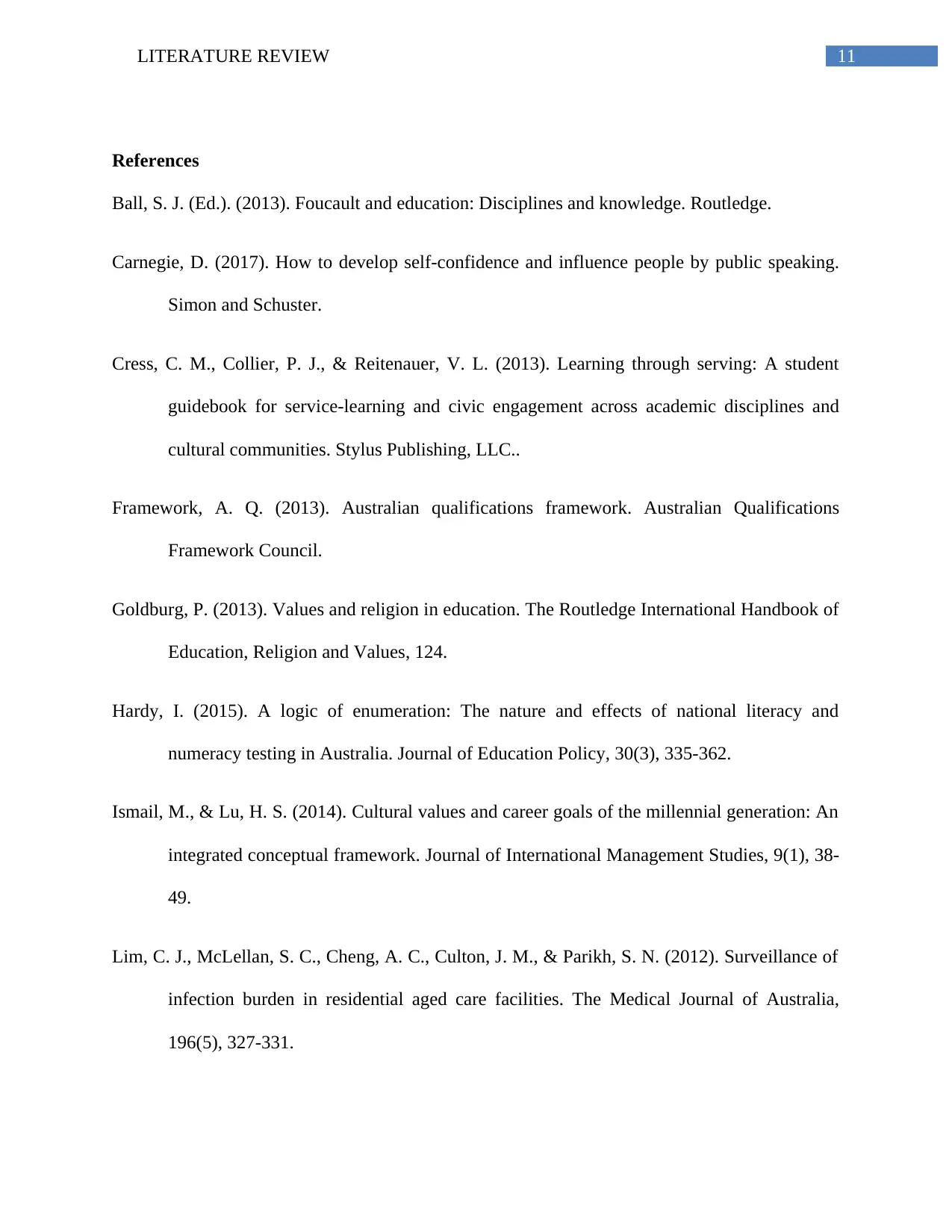
11LITERATURE REVIEW
References
Ball, S. J. (Ed.). (2013). Foucault and education: Disciplines and knowledge. Routledge.
Carnegie, D. (2017). How to develop self-confidence and influence people by public speaking.
Simon and Schuster.
Cress, C. M., Collier, P. J., & Reitenauer, V. L. (2013). Learning through serving: A student
guidebook for service-learning and civic engagement across academic disciplines and
cultural communities. Stylus Publishing, LLC..
Framework, A. Q. (2013). Australian qualifications framework. Australian Qualifications
Framework Council.
Goldburg, P. (2013). Values and religion in education. The Routledge International Handbook of
Education, Religion and Values, 124.
Hardy, I. (2015). A logic of enumeration: The nature and effects of national literacy and
numeracy testing in Australia. Journal of Education Policy, 30(3), 335-362.
Ismail, M., & Lu, H. S. (2014). Cultural values and career goals of the millennial generation: An
integrated conceptual framework. Journal of International Management Studies, 9(1), 38-
49.
Lim, C. J., McLellan, S. C., Cheng, A. C., Culton, J. M., & Parikh, S. N. (2012). Surveillance of
infection burden in residential aged care facilities. The Medical Journal of Australia,
196(5), 327-331.
References
Ball, S. J. (Ed.). (2013). Foucault and education: Disciplines and knowledge. Routledge.
Carnegie, D. (2017). How to develop self-confidence and influence people by public speaking.
Simon and Schuster.
Cress, C. M., Collier, P. J., & Reitenauer, V. L. (2013). Learning through serving: A student
guidebook for service-learning and civic engagement across academic disciplines and
cultural communities. Stylus Publishing, LLC..
Framework, A. Q. (2013). Australian qualifications framework. Australian Qualifications
Framework Council.
Goldburg, P. (2013). Values and religion in education. The Routledge International Handbook of
Education, Religion and Values, 124.
Hardy, I. (2015). A logic of enumeration: The nature and effects of national literacy and
numeracy testing in Australia. Journal of Education Policy, 30(3), 335-362.
Ismail, M., & Lu, H. S. (2014). Cultural values and career goals of the millennial generation: An
integrated conceptual framework. Journal of International Management Studies, 9(1), 38-
49.
Lim, C. J., McLellan, S. C., Cheng, A. C., Culton, J. M., & Parikh, S. N. (2012). Surveillance of
infection burden in residential aged care facilities. The Medical Journal of Australia,
196(5), 327-331.
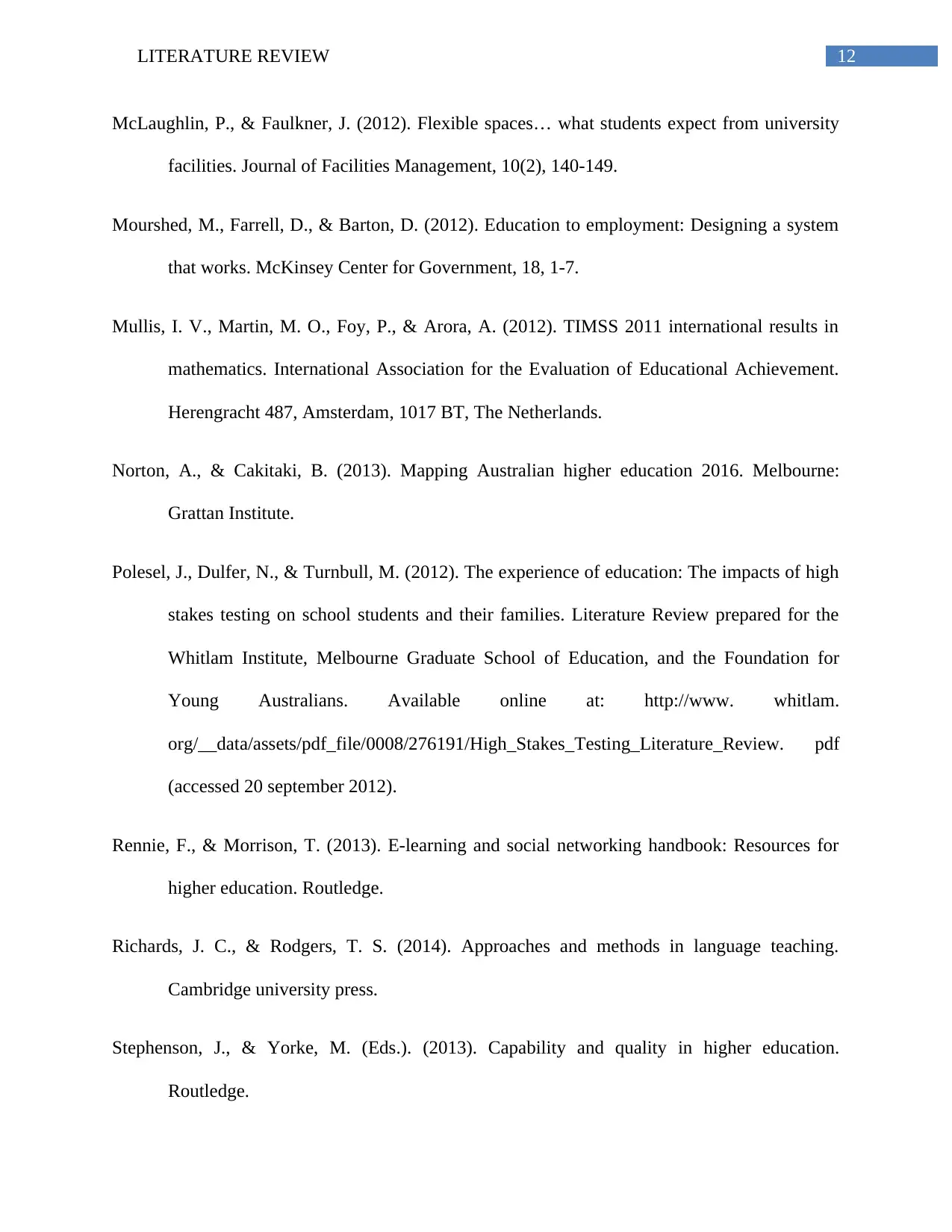
12LITERATURE REVIEW
McLaughlin, P., & Faulkner, J. (2012). Flexible spaces… what students expect from university
facilities. Journal of Facilities Management, 10(2), 140-149.
Mourshed, M., Farrell, D., & Barton, D. (2012). Education to employment: Designing a system
that works. McKinsey Center for Government, 18, 1-7.
Mullis, I. V., Martin, M. O., Foy, P., & Arora, A. (2012). TIMSS 2011 international results in
mathematics. International Association for the Evaluation of Educational Achievement.
Herengracht 487, Amsterdam, 1017 BT, The Netherlands.
Norton, A., & Cakitaki, B. (2013). Mapping Australian higher education 2016. Melbourne:
Grattan Institute.
Polesel, J., Dulfer, N., & Turnbull, M. (2012). The experience of education: The impacts of high
stakes testing on school students and their families. Literature Review prepared for the
Whitlam Institute, Melbourne Graduate School of Education, and the Foundation for
Young Australians. Available online at: http://www. whitlam.
org/__data/assets/pdf_file/0008/276191/High_Stakes_Testing_Literature_Review. pdf
(accessed 20 september 2012).
Rennie, F., & Morrison, T. (2013). E-learning and social networking handbook: Resources for
higher education. Routledge.
Richards, J. C., & Rodgers, T. S. (2014). Approaches and methods in language teaching.
Cambridge university press.
Stephenson, J., & Yorke, M. (Eds.). (2013). Capability and quality in higher education.
Routledge.
McLaughlin, P., & Faulkner, J. (2012). Flexible spaces… what students expect from university
facilities. Journal of Facilities Management, 10(2), 140-149.
Mourshed, M., Farrell, D., & Barton, D. (2012). Education to employment: Designing a system
that works. McKinsey Center for Government, 18, 1-7.
Mullis, I. V., Martin, M. O., Foy, P., & Arora, A. (2012). TIMSS 2011 international results in
mathematics. International Association for the Evaluation of Educational Achievement.
Herengracht 487, Amsterdam, 1017 BT, The Netherlands.
Norton, A., & Cakitaki, B. (2013). Mapping Australian higher education 2016. Melbourne:
Grattan Institute.
Polesel, J., Dulfer, N., & Turnbull, M. (2012). The experience of education: The impacts of high
stakes testing on school students and their families. Literature Review prepared for the
Whitlam Institute, Melbourne Graduate School of Education, and the Foundation for
Young Australians. Available online at: http://www. whitlam.
org/__data/assets/pdf_file/0008/276191/High_Stakes_Testing_Literature_Review. pdf
(accessed 20 september 2012).
Rennie, F., & Morrison, T. (2013). E-learning and social networking handbook: Resources for
higher education. Routledge.
Richards, J. C., & Rodgers, T. S. (2014). Approaches and methods in language teaching.
Cambridge university press.
Stephenson, J., & Yorke, M. (Eds.). (2013). Capability and quality in higher education.
Routledge.
Paraphrase This Document
Need a fresh take? Get an instant paraphrase of this document with our AI Paraphraser
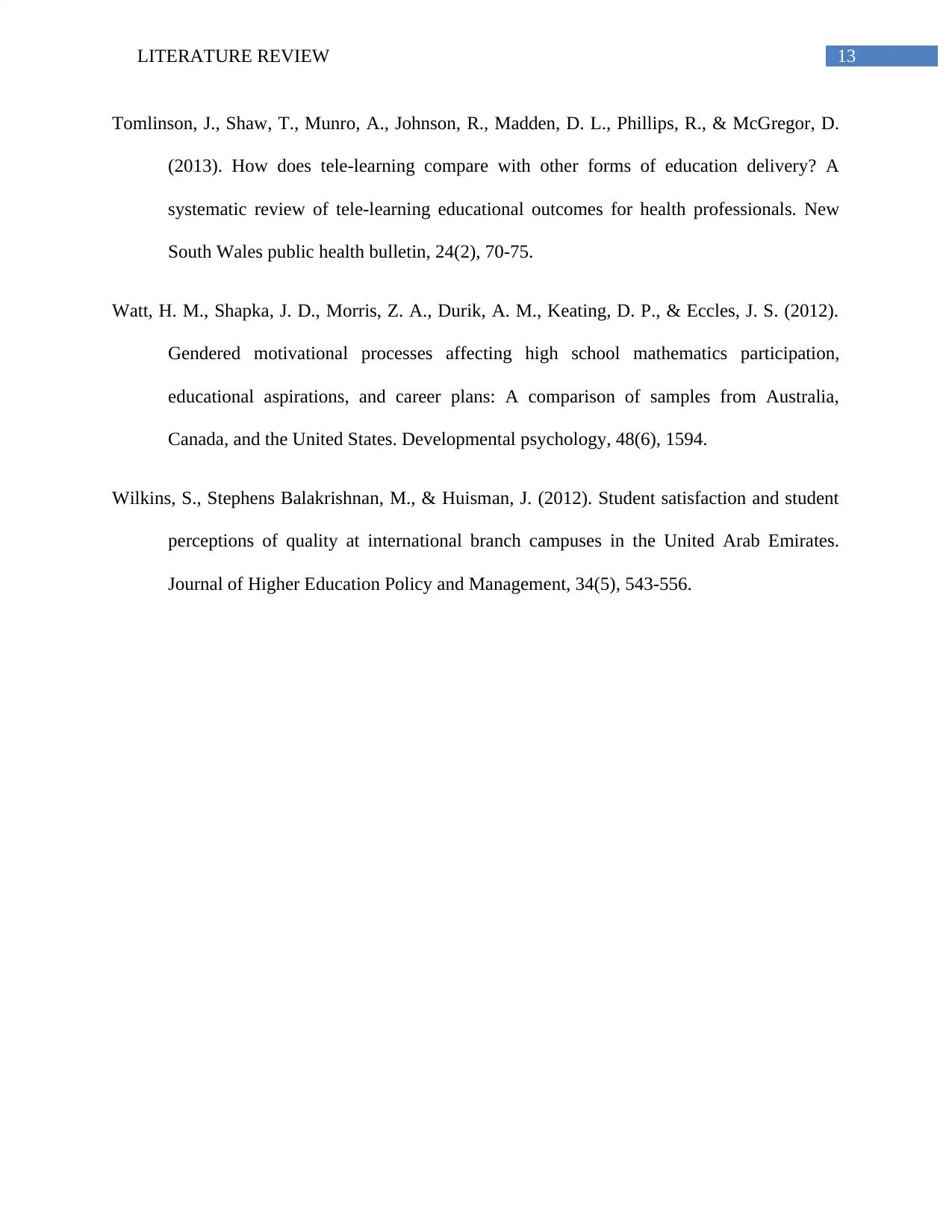
13LITERATURE REVIEW
Tomlinson, J., Shaw, T., Munro, A., Johnson, R., Madden, D. L., Phillips, R., & McGregor, D.
(2013). How does tele-learning compare with other forms of education delivery? A
systematic review of tele-learning educational outcomes for health professionals. New
South Wales public health bulletin, 24(2), 70-75.
Watt, H. M., Shapka, J. D., Morris, Z. A., Durik, A. M., Keating, D. P., & Eccles, J. S. (2012).
Gendered motivational processes affecting high school mathematics participation,
educational aspirations, and career plans: A comparison of samples from Australia,
Canada, and the United States. Developmental psychology, 48(6), 1594.
Wilkins, S., Stephens Balakrishnan, M., & Huisman, J. (2012). Student satisfaction and student
perceptions of quality at international branch campuses in the United Arab Emirates.
Journal of Higher Education Policy and Management, 34(5), 543-556.
Tomlinson, J., Shaw, T., Munro, A., Johnson, R., Madden, D. L., Phillips, R., & McGregor, D.
(2013). How does tele-learning compare with other forms of education delivery? A
systematic review of tele-learning educational outcomes for health professionals. New
South Wales public health bulletin, 24(2), 70-75.
Watt, H. M., Shapka, J. D., Morris, Z. A., Durik, A. M., Keating, D. P., & Eccles, J. S. (2012).
Gendered motivational processes affecting high school mathematics participation,
educational aspirations, and career plans: A comparison of samples from Australia,
Canada, and the United States. Developmental psychology, 48(6), 1594.
Wilkins, S., Stephens Balakrishnan, M., & Huisman, J. (2012). Student satisfaction and student
perceptions of quality at international branch campuses in the United Arab Emirates.
Journal of Higher Education Policy and Management, 34(5), 543-556.
1 out of 14
Related Documents
Your All-in-One AI-Powered Toolkit for Academic Success.
+13062052269
info@desklib.com
Available 24*7 on WhatsApp / Email
![[object Object]](/_next/static/media/star-bottom.7253800d.svg)
Unlock your academic potential
© 2024 | Zucol Services PVT LTD | All rights reserved.





